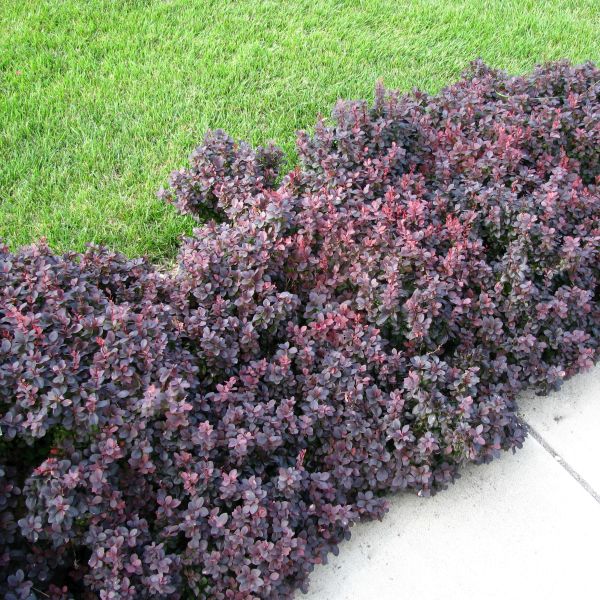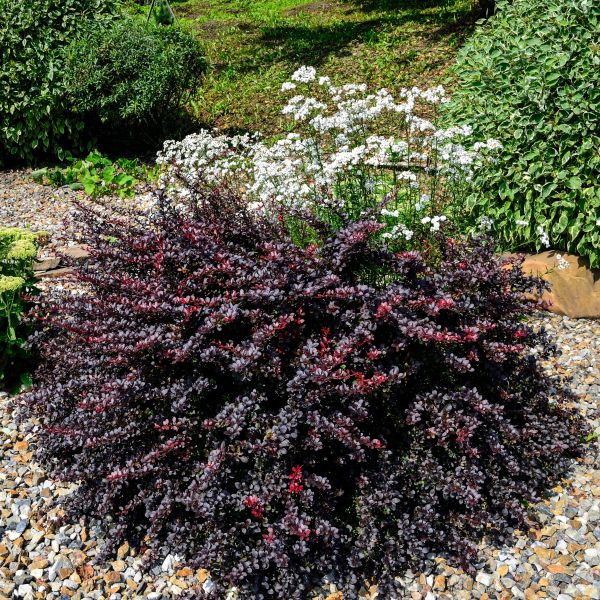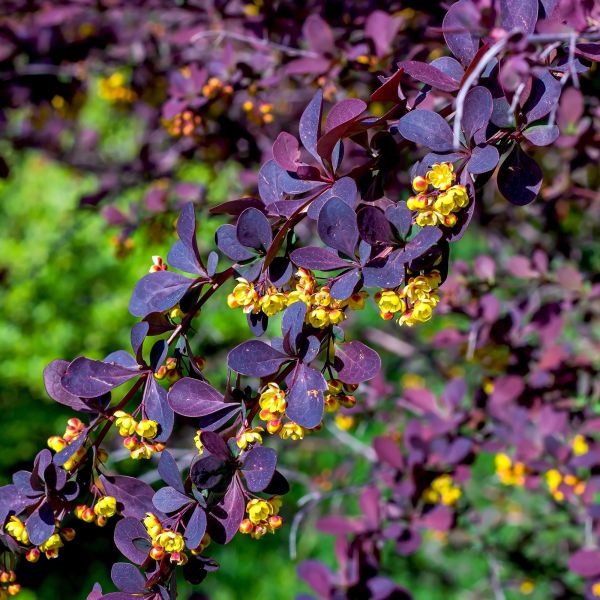


Concorde Barberry
Berberis thunbergii 'Concorde'
95 reviews
Concorde Barberry
Berberis thunbergii 'Concorde'
95 reviews
- Attractive purplish-red foliage adds color and interest to the landscape
- Low-maintenance shrub that is drought-tolerant and deer-resistant
- Compact size makes it ideal for small spaces or as a border plant
- Recommended by landscape designers for optimal fit in real yards
$88.00
$126.00
30% Off
- Ships to in 7-10 Days
- Free Shipping Over $150
- Plant Arrival Guarantee
- In Stock
- Free Plant Consult
$200 - Landscape-Approved: Every Plant We Sell Comes With Design Expertise Behind It
1.5 Gallon
We are sorry, product is currently out of stock due to seasonal availability. Please check the "Related plants available in your area" section below
Not just beautiful - intentionally selected by ShrubHub's 3D landscape design team to fit real-world spaces and maximize yard potential.
Why Concorde Barberry?
Concorde Barberry (Berberis thunbergii 'Concorde') is a popular shrub known for its deep purple foliage. This deciduous plant adds a striking contrast to any garden with its rich, wine-colored leaves. It grows to a compact size of about 3 feet tall and wide, making it suitable for smaller spaces. The Concorde Barberry also produces small yellow flowers in spring, followed by red berries in the fall. Its hardy nature and vibrant color make it a wonderful addition to any landscape.
Sunlight
Concorde Barberry plants require full sun to thrive and reach their optimal growth.
Watering
Concorde Barberry has a low to moderate watering requirement, needing regular watering during its first year to establish roots. Afterward, it can tolerate dry conditions and may only need watering during extended periods of drought.
Fertilizing
Concorde Barberry requires a balanced fertilizer with a ratio of 10-10-10 or 14-14-14. A slow-release fertilizer applied in early spring can help promote healthy growth and flowering throughout the growing season.
Concorde Barberry
Berberis thunbergii 'Concorde'
Description:
The Concorde Barberry (Berberis thunbergii 'Concorde') is a compact deciduous shrub with a stunning display of deep purple foliage. This vibrant color remains all season, providing a bold contrast against green backgrounds or other shrubs. The Concorde Barberry is a slow-growing variety that reaches a height of 2-3 feet and spreads 3-4 feet wide.
Features:
- Foliage: The Concorde Barberry's foliage is its main attraction. The leaves emerge a rich burgundy color in spring, deepening to a dark purple as the season progresses. Even in winter, the leaves retain their color, adding interest to your landscape.
- Size: This compact shrub has a rounded form, reaching an average height of 2-3 feet and a spread of 3-4 feet. It is ideal for smaller gardens, foundation plantings, or as a low hedge or border plant.
- Flowers and Fruit: In late spring to early summer, the Concorde Barberry produces small yellow flowers that give way to bright red berries. These berries persist into fall, attracting birds to your garden.
- Growth Rate: This Barberry variety has a slow to moderate growth rate, making it easy to maintain and sculpt into desired shapes. Pruning can be done in late winter or early spring to further shape the shrub.
- Hardiness: The Concorde Barberry is well-suited for USDA zones 4-8, making it adaptable to a wide range of climates. It can withstand colder temperatures and is relatively drought-tolerant once established.
Uses:
The Concorde Barberry is a versatile shrub that can be used in various ways in your landscape. Its attractive foliage color and compact size make it a perfect choice for foundation plantings, borders, or low hedges. It can also be planted in containers to add a pop of color to your patio or deck. Due to its thorny nature, it provides an effective deterrent when planted near windows or other vulnerable areas.
Care:
The Concorde Barberry thrives in well-drained soil and prefers full or partial sun exposure. It is relatively low-maintenance and has good resistance to diseases and pests. Regular watering is recommended to establish a healthy root system, especially during hot and dry periods. Applying a layer of mulch around the base of the shrub will help conserve moisture and suppress weed growth. Pruning can be done in late winter or early spring to maintain shape and remove any dead or damaged branches.
Summary:
The Concorde Barberry (Berberis thunbergii 'Concorde') is a striking deciduous shrub with deep purple foliage that adds color and interest to any landscape. Its compact size, slow growth rate, and low-maintenance nature make it an excellent choice for various garden settings. Whether used as a foundation plant, border shrub, or potted specimen, the Concorde Barberry offers beauty and versatility throughout the seasons.
Plant Information:
| Botanical Name: | Berberis thunbergii 'Concorde' |
| USDA Zones: | 4 - 8 |
| Water: | Moderate to Low |
| Exposure: | Full Sun |
| Soil Needs: | Well-Drained |
| Mature Height: | 2 - 3 feet |
| Mature Spread: | 2 - 3 feet |






Pollination Info
Pollination Information for Concorde Barberry (Berberis thunbergii 'Concorde')
About Concorde Barberry
Concorde Barberry (Berberis thunbergii 'Concorde') is a deciduous shrub known for its stunning burgundy foliage and compact growth habit. It is a popular landscaping choice due to its vibrant color and low maintenance requirements.
Blooming and Pollination
Concorde Barberry produces small, yellow flowers in spring, typically around April or May, depending on the climate. These flowers are not particularly showy but play a critical role in attracting pollinators.
Pollinators
Various insects, primarily bees and butterflies, are the main pollinators of Concorde Barberry. They are attracted to the flower's nectar and, in the process, help transfer pollen between flowers, facilitating fertilization and fruit/seed development.
Importance of Pollination
Pollination is crucial for the reproductive success and overall health of Concorde Barberry. It ensures the production of viable seeds, which eventually lead to the reproduction of the species and the growth of new plants.
Pollination Tips
- Plant Concorde Barberry in locations that receive adequate sunlight (at least 6 hours per day) to attract more pollinators.
- Provide a variety of flowering plants and shrubs nearby to attract a diverse range of pollinators.
- Avoid using pesticides or insecticides near Concorde Barberry, as they can harm or deter pollinators.
- Water the shrub regularly to ensure healthy growth and flower production.
- Consider planting multiple Concorde Barberry shrubs together to increase cross-pollination opportunities.
Conclusion
Concorde Barberry relies on pollinators, such as bees and butterflies, to ensure successful fertilization and the production of viable seeds. By providing an attractive habitat and following pollination tips, you can support the pollination process and promote the health and reproduction of this beautiful shrub.
FAQ
Frequently Asked Questions - Concorde Barberry (Berberis thunbergii 'Concorde')
General Information
-
What is Concorde Barberry?
Concorde Barberry (Berberis thunbergii 'Concorde') is a compact deciduous shrub known for its deep purple foliage and small yellow flowers. It is commonly used for ornamental purposes in landscapes and gardens.
-
How tall and wide does Concorde Barberry grow?
Concorde Barberry typically grows to a height of 2 to 3 feet (60 to 90 cm) and spreads about 3 to 4 feet (90 to 120 cm) wide.
-
What is the hardiness zone for Concorde Barberry?
Concorde Barberry is hardy in USDA hardiness zones 4 to 8.
-
Does Concorde Barberry require full sun or partial shade?
Concorde Barberry thrives best in full sun to partial shade. It can tolerate some shade, but for optimal growth and color, it is preferable to provide it with at least 6 hours of direct sunlight per day.
Care and Maintenance
-
How often should I water Concorde Barberry?
When established, Concorde Barberry is drought-tolerant and generally requires watering only during dry spells. Water deeply, ensuring the soil is moistened, but avoid overwatering as it can lead to root rot.
-
Does Concorde Barberry require pruning?
Concorde Barberry benefits from regular pruning to maintain its shape and promote new growth. Prune in early spring before new growth emerges. Remove any dead, damaged, or crossing branches. Be sure to wear gloves as the shrub has thorny stems.
-
How often should I fertilize Concorde Barberry?
Fertilize Concorde Barberry once a year in early spring with a balanced slow-release fertilizer. Follow the manufacturer's instructions for application rates.
-
Any specific soil requirements for Concorde Barberry?
Concorde Barberry prefers well-draining soil. It can tolerate various soil types, including loamy, sandy, and clay soils. However, it is best to avoid waterlogged or overly compacted soil.
Potential Issues
-
What are common pests and diseases affecting Concorde Barberry?
Concorde Barberry is relatively pest-resistant but can occasionally face issues with aphids, scale insects, or spider mites. It is also susceptible to fungal diseases like powdery mildew. Regular inspection and appropriate preventive measures, such as using insecticidal soaps or horticultural oils, can help manage these issues.
-
Is Concorde Barberry invasive?
No, Concorde Barberry is not considered invasive. However, it is prudent to prevent its seeds from spreading outside the intended cultivation area to avoid potential issues with native plant species.
Winter Care
-
Does Concorde Barberry require any special care during winter?
Concorde Barberry is generally hardy, but providing a layer of mulch around the base of the shrub in late fall can help insulate the roots and protect them from extreme cold temperatures. This mulch layer also helps conserve soil moisture.
For any other questions or concerns specific to your Concorde Barberry, consult with a local horticulturist or garden center expert.
Planting & Care
Planting & Care for Concorde Barberry (Berberis thunbergii 'Concorde')
Planting
- Select a location that receives full sun to partial shade. Concorde Barberry can tolerate a wide range of soil types but prefers well-drained soil.
- Dig a hole that is twice as wide and just as deep as the root ball of the plant.
- Gently remove the plant from its container and place it into the prepared hole.
- Backfill the hole with soil, ensuring that the top of the root ball is level with the surrounding soil.
- Water the plant thoroughly to settle the soil and remove any air pockets.
Care
- Water the Concorde Barberry regularly during the first growing season to establish a strong root system. Afterward, it only needs watering during periods of drought.
- Apply a layer of mulch around the base of the plant to conserve moisture and suppress weed growth.
- Prune the Concorde Barberry in late winter or early spring to maintain its desired shape and size. Remove any dead or damaged branches.
- Fertilize the plant in spring with a balanced slow-release fertilizer. Follow the manufacturer's instructions for application rates.
- Monitor the plant for any signs of pests or diseases, such as aphids or powdery mildew. Treat as necessary using appropriate insecticides or fungicides.
- Concorde Barberry is generally a low-maintenance plant, but regular inspection and care will help ensure its health and vigor.
Check Out These Verified Customer Reviews:
Customer Reviews
4.7 out of 5 based on 95 reviews
Thank you! Your review has been submitted.
High quality plant, great value.
Impressed with customer service.
High-quality barberry, very healthy and lush leaves.
Item has been added to your cart.


